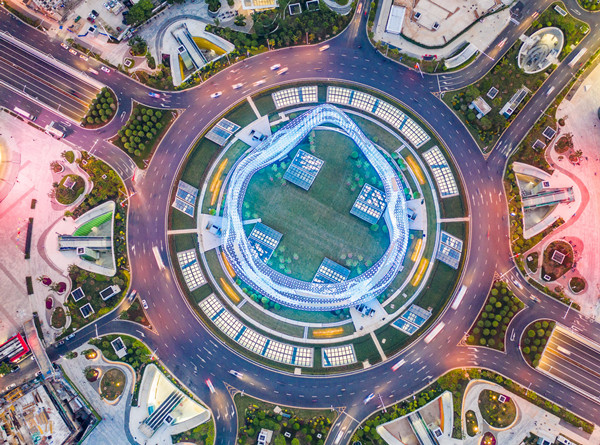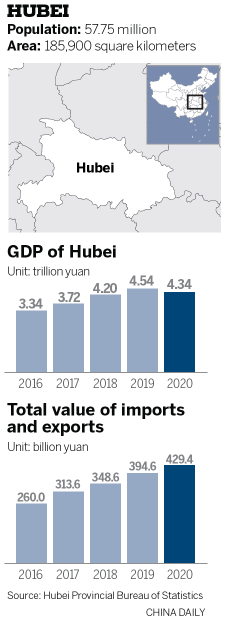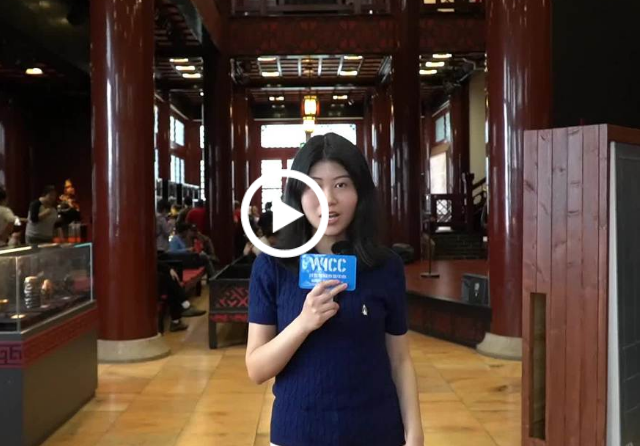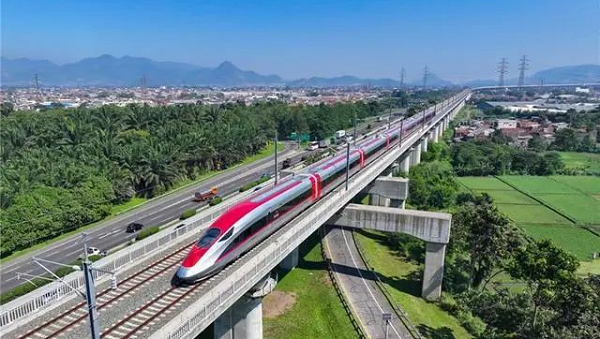Hubei homes in on hub ambitions
Editor's note: This year, the Communist Party of China is celebrating the 100th anniversary of its founding. China Daily is publishing a series of stories looking at the tremendous changes that have occurred in provinces, autonomous regions and municipalities under the leadership of the Party. They also include stories of the people and places that have left indelible marks in the Party's path to glory.

An aerial view of the Optics Valley Square in Wuhan, Hubei province. The square connects motorists to six roads above and underground while serving as the transfer station for three subway lines. A 90-meter sculpture named Star River is located at the square. ZHAO GUANGLIANG/FOR CHINA DAILY
Hubei province will step up efforts to develop itself into a strategic hub in central China, become a strong driver of growth for the country and write a new chapter in high-quality development, the province's top Party official said.
Hubei is aiming to achieve average annual GDP growth of 6.5 percent in the next five years and total GDP exceeding 6 trillion yuan ($933 billion) by 2025, hoping to maintain its high rank among Central China, according to its 14th Five-Year Plan (2021-25).
Despite a plunge of 39.2 percent of GDP in the first quarter of 2020, Hubei's GDP last year recovered to 95.6 percent from the previous year to 4.34 trillion yuan, official figures showed.
It will also strive to achieve an urbanization rate of 65 percent by the end of 2025 and ensure that per capita disposable income growth for residents basically keeps up with economic growth, the plan said.
Ying Yong, Party secretary of the Hubei Provincial Committee of the Communist Party of China, said during the 14th Five-Year Plan period, Hubei will become a converging point and play an important role in China's endeavors including the Belt and Road Initiative, the Yangtze River Economic Belt, central China's rise and the development of city clusters along the middle reaches of the Yangtze.
China has embarked on a journey of building itself into a fully modernized socialist country, and a Hubei reborn from the COVID-19 epidemic is standing at a new historic juncture, Ying said at a promotional event organized by the Ministry of Foreign Affairs in April.
"We will speed up post-epidemic recovery and high-quality development, and we will implement a development plan featuring regional coordination led by Wuhan, the provincial capital, and driven by two important cities-Xiangyang and Yichang," Ying said.
The province will follow the vision of building a community of a shared future for mankind, open up even wider to the world and continue to foster a world-class, market-oriented and law-based business environment, he said.
Hubei's success is a result of China's progress. Despite the impact of the epidemic, the province's important role in national and regional development remains unchanged, he said.
Hubei sits in the country's heartland and boasts a huge market. As a geographical center and transportation hub, it is stepping up efforts to develop itself into a national pillar for domestic circulation and a strategic link between domestic and international circulations, Ying said.
He noted that Hubei has always been in a strategic position in terms of national development. Since the founding of New China, the establishment of large, centrally administered State-owned enterprises, such as Wuhan Iron and Steel Corp and Dongfeng Motor Corp, as well as major national projects, such as the Three Gorges Dam and South-North Water Diversion Project, have solidified Hubei's vital role in the country.
As a pioneer in the development of China's modern industries, Hubei has a complete industrial system. There are 17 industries with revenues of more than 100 billion yuan, including automaking, electronic information and biomedicine. Emerging industry clusters including those related to optical communications, computer chips, smart terminals and digital economics, are also gaining momentum.
Notching victories
Apart from winning the fight against the epidemic, Hubei overcame floods caused by one of the heaviest rainfalls in the history of the People's Republic of China and ended absolute poverty for all remaining impoverished residents last year, Ying said. The province also achieved victory in terms of its socioeconomic development.
"We put life and people above everything else, raced against time, fought hard against a ferocious virus and secured a decisive victory in defending Hubei and Wuhan in some three months," Ying said.
With ongoing epidemic containment measures in place, the province adopted a region specific approach to help enterprises resume work and production and facilitated the simultaneous recovery of industrial chains' upstreams, or materials needed for production, and downstreams, or the production and distribution of their products, he said.
Hubei arranged point-to-point transportation for 700,000 workers to get back to their posts as well as 37 chartered flights for more than 2,900 workers to return from abroad, Ying said.
Thanks to the packages of policies rolled out by the central government, the province has helped market entities survive and thrive; for example, it cut more than 100 million yuan in taxes and fees for them. Despite the severe impact from the epidemic, Hubei saw an increase of 290,000 new market entities and more than 700,000 new urban jobs last year, he said.
A total of 321 Fortune 500 companies have made investments in Hubei, and the Honeywell Emerging Market Headquarters and Innovation Center was inaugurated in Wuhan shortly after the city's lockdown was lifted in April last year, he said.
The province launched 10 major projects with a total investment of 2.3 trillion yuan for post-epidemic recovery. Hubei is advancing disease prevention reform that prioritizes prevention and treatment and strengthening public health systems focusing on grassroots level capacity, Ying said.
It plans to build one top level hospital for every city or county with more than 1 million residents, add another 10,000 permanent posts to boost grassroots healthcare and ensure that each village has at least one doctor with a university degree, he added.
"Despite the COVID-19 epidemic, the economic fundamentals sustaining Hubei's sound growth in the long run-as well as the province's comprehensive strength that has been developed over the years-remain unchanged."
Hubei prospering
Hubei reported a GDP expansion of 58.3 percent to reach 987.27 billion yuan during the first quarter of this year, recovering from a 40-percent plunge during the same period last year, according to official figures.
Hubei has flourished in various ways.
For example, it offers convenient transportation. Almost all major Chinese cities can be reached from Hubei in under four hours. The province is linked to the Pacific Ocean by the Yangtze's waterways and Europe and Central Asia by China-Europe freight trains. It also boasts 64 international and regional flights.
The province also has abundant intellectual talent and innovation potential, with 129 institutions of higher learning and more than 1.6 million college students, he said, adding that Wuhan has more university students than any other city in China.
Further, with 29 national key laboratories, more than 3,600 research institutions, over 80 academicians of the Chinese Academy of Sciences and Chinese Academy of Engineering and 19 national engineering research centers, Hubei has shown it is also committed to developing itself into a national scientific innovation hub.





